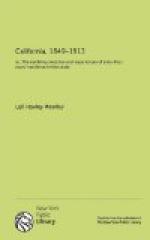The Take of A Young Bull.
In 1870 I was in the produce commission business in San Francisco and had a consignor in Vacaville by the name of G. N. Platt who had been presented with a fine young bull by Frank M. Pixley, who lived in Sausalito, in the hills about two miles from town. Mr. Platt requested me to go and get the bull and ship him to Vacaville, so I left next morning for Sausalito. Here I sought a man who could throw the lasso. After two hours I found the man I wanted. He had the mustangs and all the necessary equipment. We mounted and left for Mr. Pixley’s residence where we were informed that the animal we wanted was somewhere in the hills with the other cattle. This was rather indefinite information, but we had to make the best of it and started out. Our mustangs were well calculated for the occasion and we went over the hills like kites. Finally we saw some cattle about a mile away and we made for them, found what we were in search of and made for him. He had horns about two inches long and was as light on his feet as a deer, and gave us a lively chase for about one hour. When we had him at the end of a rope he was determined to go just the opposite way than we wanted him to, but the man and the mustang at the other end of the rope had their way part of the time, so after about two hours hard fighting we succeeded in getting the little fellow down to the wharf where I found that there would not be another boat until after dark, so I concluded to wait and come over in the morning and ship him. The next thing was to dispose of the bull for the night. I said, “Here is a coal bunker, we will put him in here.” So after getting permission we started for it with the bull at one end of the rope and the vaquero at the other. The bull got a little the better of the man and went up the wharf full tilt with the vaquero in tow. The vaquero said, “There is a post on the wharf, the bull will go one side and I will go the other and round him up.” But he got rounded up himself and left sprawled out on the wharf.




